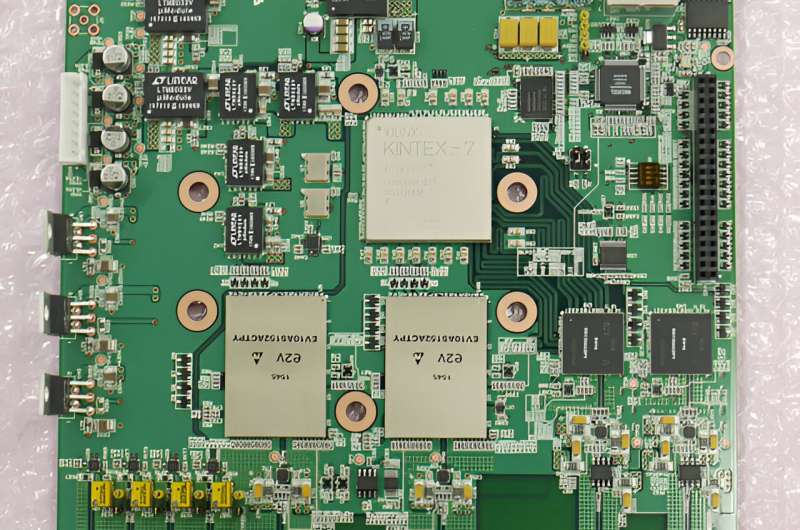The race to develop quantum computers has really heated up over the past few years. State-of-the-art systems can now run simple algorithms using dozens of qubits—or quantum bits—which are the building blocks of quantum computers.
Much of this success has been achieved in so-called gate-based quantum computers. These computers use physical components, most notably superconducting circuits, to host and control the qubits. This approach is quite similar to conventional, device-based classical computers. The two computing architectures are thus relatively compatible and could be used together. Furthermore, future quantum computers could be fabricated by harnessing the technologies used to fabricate conventional computers.
But the Optical Quantum Computing Research Team at the RIKEN Center for Quantum Computing has been taking a very different approach. Instead of optimizing gate-based quantum computers, Atsushi Sakaguchi, Jun-ichi Yoshikawa and Team Leader Akira Furusawa have been developing measurement-based quantum computing.
Measurement-based computing
Measurement-based quantum computers process information in a complex quantum state known as a cluster state, which consists of three (or more) qubits linked together by a non-classical phenomenon called entanglement. Entanglement is when the properties of two or more quantum particles remain linked, even when separated by vast distances.
Measurement-based quantum computers work by making a measurement on the first qubit in the cluster state. The outcome of this measurement determines what measurement to perform on the second entangled qubit, a process called feedforward. This then determines how to measure the third. In this way, any quantum gate or circuit can be implemented through the appropriate choice of the series of measurements.
Measurement-based schemes are very efficient when used on optical quantum computers, since it’s easy to entangle a large number of quantum states in an optical system. This makes a measurement-based quantum computer potentially more scalable than a gate-based quantum computer. For the latter, qubits need to be precisely fabricated and tuned for uniformity and physically connected to each other. These issues are automatically solved by using a measurement-based optical quantum computer.
Importantly, measurement-based quantum computation offers programmability in optical systems. “We can change the operation by just changing the measurement,” says Sakaguchi. “This is much easier than changing the hardware, as gated-based systems require in optical systems.”
But feedforward is essential. “Feedforward is a control methodology in which we feed the measurement results to a different part of the system as a form of control,” explains Sakaguchi. “In measurement-based quantum computation, feedforward is used to compensate for the inherent randomness in quantum measurements. Without feedforward operations, measurement-based quantum computation becomes probabilistic, while practical quantum computing will need to be deterministic.”
The Optical Quantum Computing Research Team and their co-workers—from The University of Tokyo, Palacký University in the Czech Republic, the Australian National University and the University of New South Wales, Australia—have now demonstrated a more advanced form of feedforward: nonlinear feedforward. Nonlinear feedforward is required to implement the full range of potential gates in optics-based quantum computers. The findings are published in the journal Nature Communications.
“We’ve now experimentally demonstrated nonlinear quadrature measurement using a new nonlinear feedforward technology,” explains Sakaguchi. “This type of measurement had previously been a barrier to realizing universal quantum operations in optical measurement-based quantum computation.”

Optical computers
Optical quantum computers use qubits made of wave packets of light. At other institutions, some of the current RIKEN team had previously constructed the large optical cluster states needed for measurement-based quantum computation. Linear feedforward has also been achieved to construct simple gate operations, but more advanced gates need nonlinear feedforward.
A theory for practical implementation of nonlinear quadrature measurement was proposed in 2016. But this approach presented two major practical difficulties: generating a special ancillary state (which the team achieved in 2021) and performing a nonlinear feedforward operation.
The team overcame the latter challenge with complex optics, special electro-optic materials and ultrafast electronics. To do this they exploited digital memories, in which the desired nonlinear functions were precomputed and recorded in the memory. “After the measurement, we transformed the optical signal into an electrical one,” explains Sakaguchi. “In linear feedforward, we just amplify or attenuate that signal, but we needed to do much more complex processing for nonlinear feedforward.”
The key advantages of this nonlinear feedforward technique are its speed and flexibility. The process needs to be fast enough that the output can be synchronized with the optical quantum state.
“Now that we have shown that we can perform nonlinear feedforward, we want to apply it to actual measurement-based quantum computation and quantum error correction using our previously developed system,” says Sakaguchi. “And we hope to be able to increase the higher speed of our nonlinear feedforward for high-speed optical quantum computation.”
“But the key message is that, although superconducting circuit-based approaches may be more popular, optical systems are a promising candidate for quantum-computer hardware,” he adds.
More information:
Atsushi Sakaguchi et al, Nonlinear feedforward enabling quantum computation, Nature Communications (2023). DOI: 10.1038/s41467-023-39195-w
Citation:
Researchers take a different approach with measurement-based quantum computing (2023, December 21)
retrieved 22 December 2023
from
This document is subject to copyright. Apart from any fair dealing for the purpose of private study or research, no
part may be reproduced without the written permission. The content is provided for information purposes only.

